A Private Tour today, down in the Brecks. It was a day to be spent looking for Lesser Spotted Woodpecker first, and then the other specialities of the region. The weather forecast had been really bad a couple of days ago, for rain all day, but it was now expected to rain overnight and dry up by early morning, which was a good deal more promising.
It was dry when we met up in the Brecks early in the morning, a good start, even though it had rained overnight. As we walked down along the river, we could hear Green Woodpecker and Great Spotted Woodpecker calling, as well as several Nuthatch. A Water Rail squealed from the reeds in its usual spot, but remained well hidden.
It didn’t take long to get to the Lesser Spotted Woodpeckers’ favoured spot, even though the path was a bit muddy this morning. As we stood looking up into the trees, we could hear a Great Spotted Woodpecker drumming further back. We had only been there a couple of minutes when a small bird flew across and landed high up in one of the trees. Through binoculars, we could see it was one of the Lesser Spotted Woodpeckers. Great!
The Lesser Spotted Woodpecker flew across to a dead tree and spent a couple of minutes climbing up and down the trunk and branches, picking at the bark, and even drumming once or twice. This gave us a chance to get the scope onto it. Through the scope, we could see that it was the female, with a dark cap (the male Lesser Spotted Woodpecker has red on the crown). We could also see the barred back and wings, lacking the bold white shoulder flash of a Great Spotted Woodpecker. And it was very small!
 Lesser Spotted Woodpecker – the female perched for some time in the trees
Lesser Spotted Woodpecker – the female perched for some time in the trees
After a while, the Lesser Spotted Woodpecker flew across and up into the higher branches of one of the taller trees. It perched there on a branch for several minutes, preening. At one point it called, a high pitched ‘ki, ki, ki’. Then it flew off further through the block of tress and we lost sight of it. We heard it call further along briefly, but by the time we had stopped to look at a Green Woodpecker in the trees, we had lost track of it.
At that point it started to rain again. Rather than stand around and wait for the Lesser Spotted Woodpecker to show itself again, we had a walk further along the path. We had heard several Mandarin flying round beyond the trees while we were watching the woodpecker, so we walked further up to take a look. There they were, two pairs, perched high up in a large dead tree. It is always quite incongruous seeing ducks high in a tree, although Mandarins are tree nesters.
 Mandarin – 3 of the 4, perched high in a tree
Mandarin – 3 of the 4, perched high in a tree
A little further along still, we could hear a big noisy flock of Siskin in the alders over the path. We walked very slowly up to them, until we were under the trees. There were dozens of Siskin in the branches, but looking through carefully we found two browner Lesser Redpoll in with them too, which dropped down to join the Siskin feeding on the alder cones.
It was still raining, although mercifully it wasn’t very hard. So, when we got back to where the Lesser Spotted Woodpecker had been, and having had great views of one already this morning, we decided to not to hang around. A Kingfisher called, but we didn’t see it as it zoomed away along the river from behind a fallen tree. We heard Bramblings and Redwings in the trees too on the walk back to the car.
We had been hoping the more recent weather forecast would have been correct and today would have been dry all day, but given that it was still raining we decided on a change of tack. It was a bit early in the day to go looking, but we thought it might be a good opportunity to try for some gulls at Thetford while it was wet. As we drove onto the industrial estate where they have been feeding, the skies looked rather quiet. As we turned the corner and could the roof on which they have been loafing, there were just six birds there. However, even without stopping, one immediately stood out.
Big and pale, it was the juvenile Glaucous Gull which has been here on and off for several weeks now. We got out and got it in the scope, noting the pale biscuit colour overall, pale wingtips, and large, pink-based, dark-tipped bill.
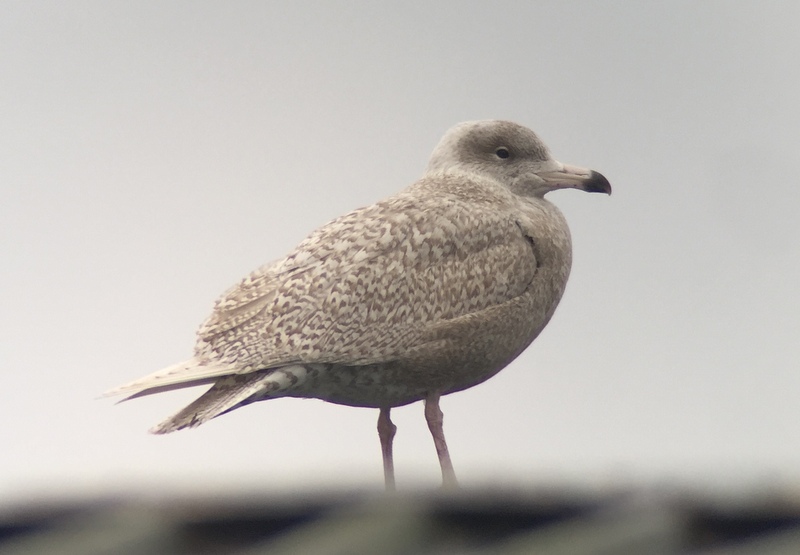 Glaucous Gull – the juvenile still on the industrial estate in Thetford
Glaucous Gull – the juvenile still on the industrial estate in Thetford
There have sometimes been other gulls here too, and we were planning to wait to see if any others came in, but rather than stand in the rain we decided to go get a cup of tea and a bacon roll in the cafe across the road. Delicious! And we could still see the Glaucous Gull on the roof from the window of the cafe! When we came out again, there were still not many more gulls – around half a dozen Herring Gulls and a couple of Lesser Black-backed Gulls. However, it had now stopped raining, and we wanted to head off to look for Goshawks this morning, so we headed off back to the Forest. Even better, it brightened up on the way, patches of blue sky appeared and the sun came out. This wasn’t in the forecast, but it was most welcome anyway.
It was not long before we were watching our first Goshawk of the day circling up out of the Forest. It was a juvenile male, brown-toned above and orangey below as it turned in the light. It was rather distant, but it was a good start. Then another Goshawk appeared, also a juvenile. This one was a female, larger than the male. It started displaying, flying over the trees with deep, exaggerated wingbeats.
Then another female Goshawk appeared, and it too started displaying, closer to us. It was not a juvenile, whiter below, but with quite a dark grey back, so possibly a two year-old (or 3rd calendar year) female. At one point it was pursued by a juvenile male, presumably the same one we had seen earlier. Finally an adult appeared too. It circled up out of the trees closer still to us, and began to display as it flew off over the Forest away from us.
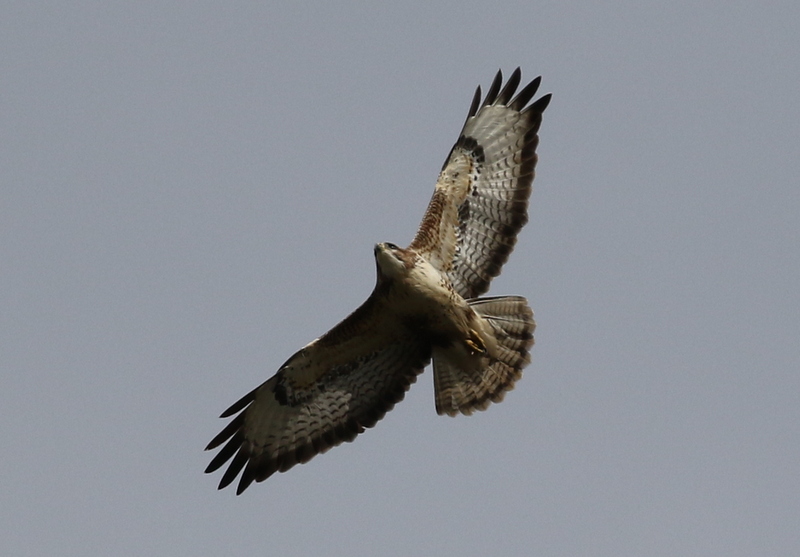 Common Buzzard – there were lots of these up too today, in the sunshine
Common Buzzard – there were lots of these up too today, in the sunshine
There were other birds here too. Several Common Buzzards of various degrees of paleness circled up on the warming air, calling. A Sparrowhawk flew out of the wood too and disappeared high into the sky. A Woodlark was singing nearby and a flock of Fieldfares was calling noisily from the trees behind us.
Having already enjoyed good view of the Goshawks, we were just thinking about leaving when all the pigeons scattered from the trees in front. A few seconds later, a juvenile Goshawk circled out and drifted towards us. Great stuff! It had been all action here for about an hour, but we had lots of other things we wanted to do today, so at that point we did decide to move on.
 Goshawk – a juvenile, which circled out towards us
Goshawk – a juvenile, which circled out towards us
The Great Grey Shrike has been erratic at Cockley Cley in the last few weeks, roaming over a large area, but having been reported there for the last two days we decided to give it a go. As we drove up, we flushed a couple of Bullfinch from a puddle on the edge of the road. The clearing where the Great Grey Shrike had been originally was rather quiet, despite a departing photographer telling us that it was ‘always in that one tree’ out in the middle. We carried on a bit further, in case it might be in a different tree today!
As we walked along we could hear a Woodlark calling softly ahead of us. A scan of the ground as we went along revealed nothing, but when it started singing softly, we realised we must have gone past it. Thankfully it had come out of the furrows where it must have been hiding and was now standing on top of a tussock. It walked back down again, out of view, and we made our quietly way back to the row it was on and found it feeding quietly in the grass.
 Woodlark – feeding quietly in the grass
Woodlark – feeding quietly in the grass
As we continued on along the path, a bright male Yellowhammer perched in a tree above our heads calling. The Great Grey Shrike had been reported further round yesterday, so we carried on down the next track. A Brimstone butterfly fluttered past, enjoying the warmth from the sun now. As we arrived at a small plantation, the Great Grey Shrike suddenly appeared on the top of a bush in front of us.
 Great Grey Shrike – we had great views of it today
Great Grey Shrike – we had great views of it today
We walked round a little to get the sun behind us, and were soon enjoying stunning views of the Great Grey Shrike. It perched on the very top of a small tree, back on at first, then turned and gave us a look at it from the front. It was focused on the ground below, looking for food. Eventually it flew straight towards us, across the ride, and perched up in the top of a young oak tree behind. With the sun now the wrong side of us, we left it to its hunting.
As we made our way back to the car, a large, hairy Fox Moth caterpillar was making its way across the track. Back at the road, we could hear redpolls calling, and three Lesser Redpolls flew out of the birches nearby.
Our final destination for the day would be Lynford, but having had such a successful morning, we had an hour to two to spare. We drove round to Lakenheath Fen. After a quick break for lunch, we set out across the reserve. We did not have much time to spend here today, so it was a very brisk walk. A quick look at New Fen added a few species for the day – Gadwall, Common Snipe, Teal and Coot. The pools by the path had a couple of Great Crested Grebe and a few Tufted Ducks.
From the Joist Fen viewpoint, we could see a few Marsh Harriers up, but there was nothing in the paddocks today. There was more activity up on the river bank. There were lots of geese down by the river, mostly Greylags and Canada Geese, but five White-fronted Geese were hiding in with them. Further along, there were lots of Wigeon on the water.
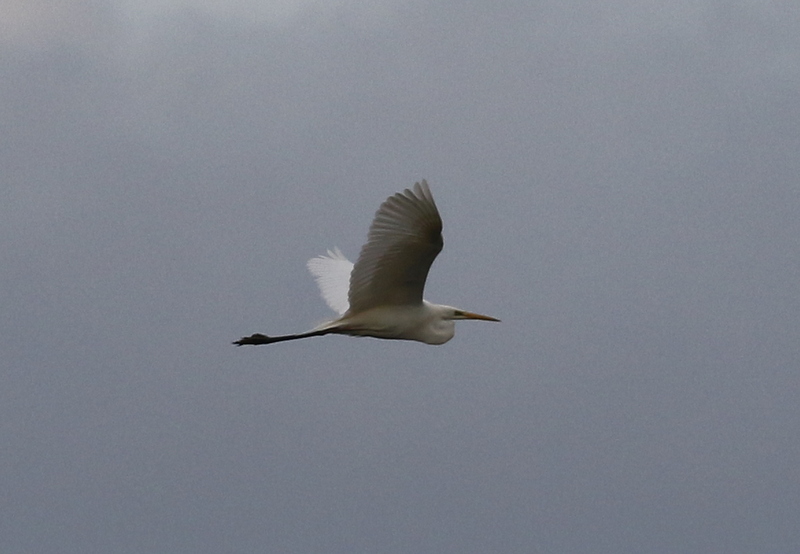 Great White Egret – flew past along the river
Great White Egret – flew past along the river
While we were watching the geese, a Great White Egret flew lazily past along the river. The Little Egret which flew up from down by the water further on was much smaller by comparison. We had hoped to see the Cranes here today. We only really had enough time to look for one of the pairs but there was no sign of them in their usual haunts – they could have been in the reeds or off the reserve to the south. We had to get back if we wanted to be at Lynford in good time, so it was another brisk walk back to the visitor centre.
Round at Lynford Arboretum, we walked down the path from the car park. The feeders were empty, and it looked rather quiet under the trees, but just beyond we could hear Hawfinches calling. Walking round to the other side of the trees, we spotted a male in the tops. Getting the scope on it, it was joined by a female, and then a second male. They can be surprisingly hard to see in the trees, for such a large bird, so there were probably more in there where we couldn’t see them.
 Hawfinch – one of the males, up in the trees
Hawfinch – one of the males, up in the trees
There were also lots of Bramblings around the bushes here. A Crossbill flew over calling. When the Hawfinches dropped back down into the trees out of sight, we could still hear them calling. We walked up and down past the trees a couple of times, scanning, and eventually one came out on the grass, a female. It was quickly joined by a second female, but when the male flew out, it spooked all of them and they all flew back into the trees.
 Hawfinch – a greyer female feeding down in the grass
Hawfinch – a greyer female feeding down in the grass
The clearing just beyond the trees has been recently cultivated and there were lots of birds dropping down onto the bare earth. Thrushes were well represented – several Redwings, a Song Thrush or two, and three Mistle Thrushes. A pale, silvery grey White Wagtail was feeding with three darker Pied Wagtails, a spring migrant stopping off on its way north. We could hear Woodlark calling and singing and eventually found them – one feeding on the ground was colour ringed, but the other flew up into the air overhead, singing.
Down at the bridge, there was some seed put out for the birds. The first two we saw here were a Marsh Tit and a Nuthatch, both target birds for day’s list. There were also Coal Tits, Blue Tits and Great Tits. A couple of Siskin came down to drink nearby.
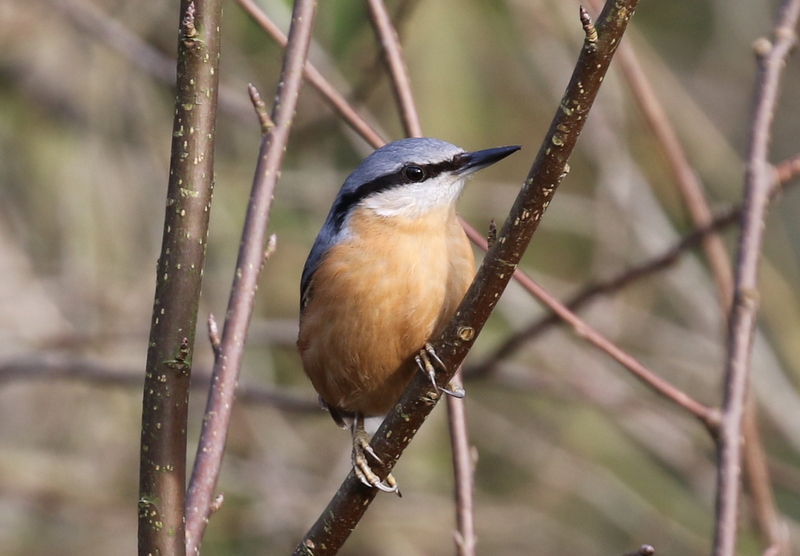 Nuthatch – coming down to seed at the bridge
Nuthatch – coming down to seed at the bridge
We could hear Crossbills calling close by, and we looked across and saw a smart red male Common Crossbill perched up in one of the alder trees in the paddock. We had to walk down the path a short way to get the sun behind us, but were then treated to great close up views of it.
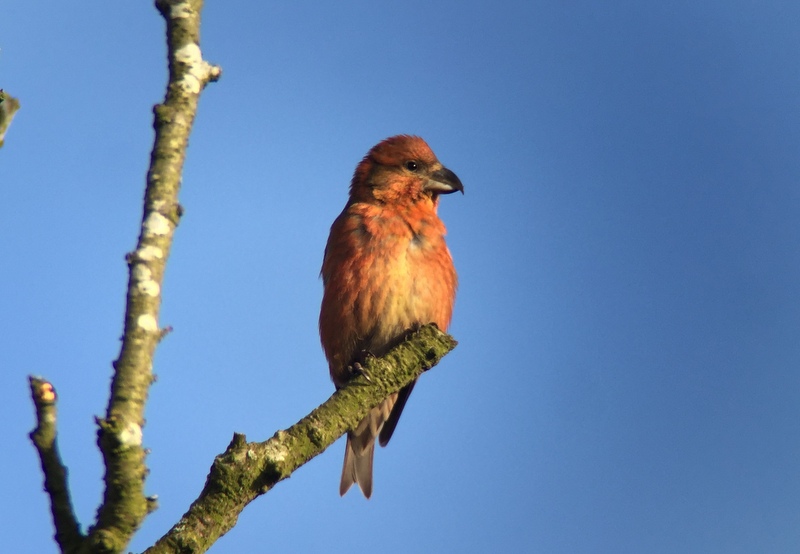 Common Crossbill – the male perched up in a low tree, preening & calling
Common Crossbill – the male perched up in a low tree, preening & calling
There was actually a pair of Crossbills in the trees here. The male perched out in the top of one of the trees in the open, enjoying the afternoon sunshine. We watched it preening, and could hear it calling. Great views. The duller, grey-green female was lurking deeper in one of the thicker alder trees a little further back.
The list for the day was still missing a few more obvious birds which we should have seen, so we had a quick walk round the lake. Two Treecreepers flew ahead of us between the trees along the edge of the water. We heard a Little Grebe calling and following the ripples we found it lurking under the overhanging trees at far end. A Grey Wagtail flew off calling, towards Lynford Hall. A pair of Mandarin were sleeping on the grass beyond the lake, among the molehills.
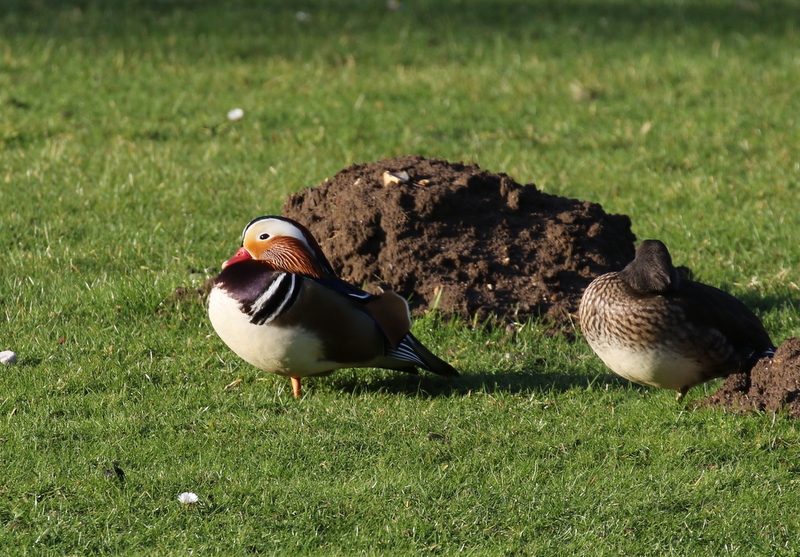 Mandarin – a pair, down by the lake in front of Lynford Hall
Mandarin – a pair, down by the lake in front of Lynford Hall
Then it was time to make our way back to the car. What a day it had been! A real bonanza of birds in the Brecks.
















